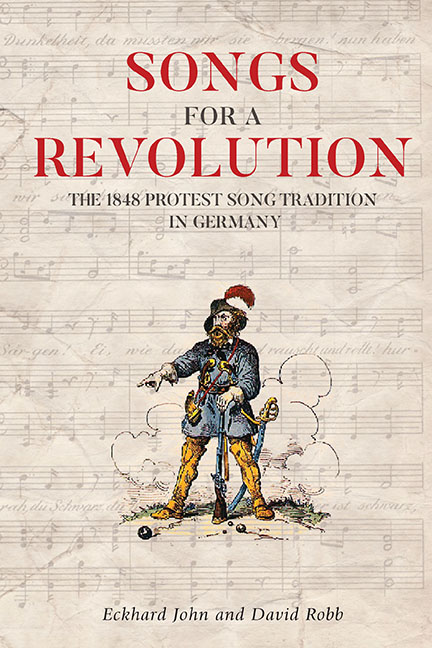Book contents
- Frontmatter
- Contents
- Preface
- Introduction: The Emergence of Political Song 1830–48
- Part I Before 1848: The Vormärz
- Part II 1848–49
- Part III 1848 in Memory
- Conclusion: The Making of Tradition; The Protest Songs of 1848 in the German Folk Revival 303
- Bibliography
- Discography
- Index of Names and Terms
- Index of Song Titles
12 - “Was zieht dort zur Brigittenau”
Published online by Cambridge University Press: 23 October 2020
- Frontmatter
- Contents
- Preface
- Introduction: The Emergence of Political Song 1830–48
- Part I Before 1848: The Vormärz
- Part II 1848–49
- Part III 1848 in Memory
- Conclusion: The Making of Tradition; The Protest Songs of 1848 in the German Folk Revival 303
- Bibliography
- Discography
- Index of Names and Terms
- Index of Song Titles
Summary
THE BALLAD “Was zieht dort zur Brigittenau” (What's On the March to Brigittenau) is a historical song documenting the death of Robert Blum. It was written by the Oldenburg author Adolf Stahr (1804–76) as an immediate reaction to the execution of Blum, one of Germany's leading democrats, on November 9, 1848, near Vienna. The politician was a delegate in the Frankfurt National Assembly and a charismatic speaker, and his death unleashed indignation throughout the whole of Germany. Stahr's song was one of many written at that time expressing consternation at Blum's murder. In twentieth-century reception, however, this situation changed: after coming back into circulation around 1960 in the GDR, “Was zieht dort zur Brigittenau” was the only prominent Robert Blum song to feature in the repertoires of the Liedermacher and groups of the new West German folk movement of the 1970s.
The origin of the song is directly connected to the historical course of events: in October 1848 Blum had traveled to Vienna with a delegation of democrats from the Frankfurt National Assembly to bring a message of support to the rebels there. The Vienna insurgency in October was the last uprising of the Austrian revolution of 1848. Impressed by the revolutionary zest of the Viennese, Blum actively took part in the military defense of the city, which was under siege by the Imperial troops. After the storming of Vienna by the counterrevolutionary forces, Blum was arrested on November 4 and—despite his immunity as a member of parliament—was executed five days later in Brigittenau near Vienna. The shooting of Robert Blum aroused a wave of anger in Germany that resulted in numerous funeral services being held throughout the whole country. With regard to the service in Bremen on November 19, 1848 (fig. 12.1), Adolf Stahr wrote the text “Was zieht dort zur Brigittenau” to the melody of the popular song of the time “Schier dreißig Jahre bist du alt.” Born in Prenzlau, Stahr had a doctorate in literary history and, since 1836, had been vice principal of a Gymnasium in Oldenburg. He published on a variety of themes and was active in the literary and political life of the period. His “Brigittenau” song first appeared in the Bremer Zeitung on Saturday November 18, 1848, the day before the memorial service for Robert Blum.
- Type
- Chapter
- Information
- Songs for a RevolutionThe 1848 Protest Song Tradition in Germany, pp. 176 - 186Publisher: Boydell & BrewerPrint publication year: 2020



